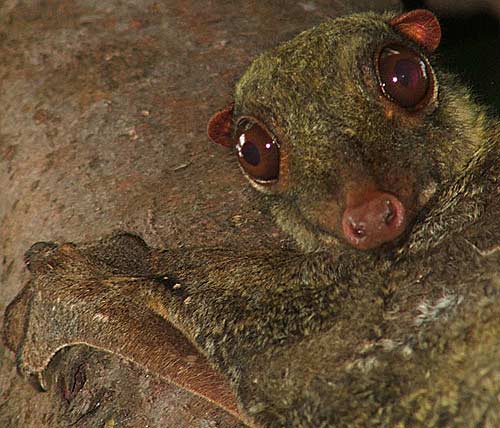Flying Lemur

The rainforests of tropical Asia provide plenty of towering trees as launch pads for the flying lemur. This arboreal mammal uses a thin, blanket-like membrane extending between its front and hind limbs to glide through the jungle in silent escape. Flying squirrels also have a membrane, but their tails are busy and free; the tails of flying lemurs are attached to the skin layer.
A clumsy and awkward animal, flying lemurs move slowly and cling spread-eagled to tree trunks. They climb up in short hopping bursts to get high enough for a leap to the next tree. Mottled in shades of gray and reddish-brown, these colors resemble bark that gives the animal some camouflage protection. They roost in old tree holes or sit in the upper crowns and feed on leaves, flower buds and tree sap. When resting, flying lemurs, also called colugos, hang upside down while clutching branches with strong claws.
Found all over Southeast Asia from Myanmar (Burma) to Vietnam, south to Malaysia and Indonesia, it is not difficult to observe flying lemurs on jungle walks in national parks and island forests. Active after dusk, mostly at night, and in early mornings, these shy forest creatures avoid getting on the ground where they are helpless to defend themselves. Do not confuse flying lemurs with other lemurs, which are true primates found only in Madagascar.
The treetops offer the best protection from predators, using flight to move to safety. Some flying lemurs were measured gliding over 130 meters through the forest. Dropping like a freefalling hang glider in the air, these furry flyers lift their heads up and land with all four limbs clenching together on the lower end of rainforest trees. Hunting and loss of habitat are the main threats to these solitary forest dwellers.
Rainforest Tribal Legend
The flying lemur was once considered a respected forest animal. One day he was asked to settle feeding ground disputes among fighting flying squirrels. The cagy flying lemur told the squirrels to move away from the lush rainforest until it could survey the best food sources to share among the squirrel groups. No decision was made even after one year. Becoming impatient, the squirrels returned to find the flying lemur engorged on the sweetest fruits and flowers of the forest. Flying into a rage, the squirrels pounced on the lemur and cut off its tail and chased him far away. Today the flying lemur has no visible tail and only flies at night in fear of its wrathful neighbors.
